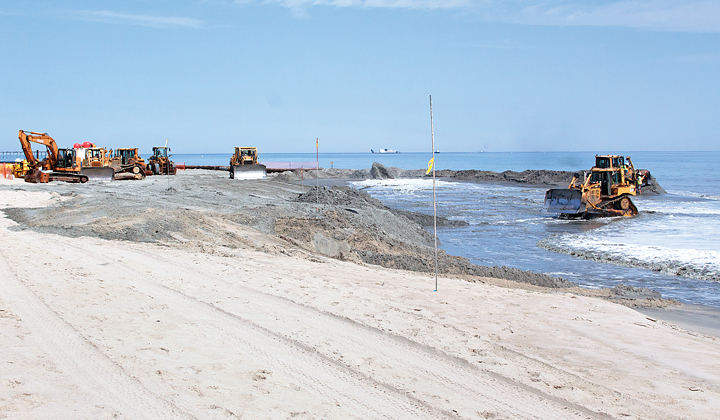Dredging crews pumping sand onto Carolina and Kure’s beach strands are pushing to meet an April 30 deadline, but since they were hindered by weather for 38 days this winter, they’ve enlisted the help of a second dredging company to finish on time.
Marinex Construction Co. started the beach renourishment project Jan. 11, and with the help of Norfolk Dredging they expect to finish within the environmental window, which is Nov. 16 to April 30. The window was created to minimize impacts to nesting turtles and birds, Army Corp of Engineers project manager Bob Keistler said.
But cost is another incentive for dredging crews to finish on time. Multiple dredges and 30,000 linear feet of pipe are involved in the project, and having that equipment deployed “is costing him money every day, whether they’re dredging or not,” Keistler said.
Kure Beach’s dredging is especially susceptible to bad weather because while Carolina Beach’s sand is pumped out of Carolina Beach Inlet, Kure Beach’s sand is pumped from five miles offshore. The exposed nature of that location means that dredge contends with higher seas and its safe harbor, Masonboro Inlet, is further away.
Because it takes the Kure Beach dredge 2.5 hours to reach safe harbor, crews can’t wait until bad weather arrives to seek shelter.
“They have to act based on forecast,” Keistler said. “Then, once they have clear conditions, they have to tow the dredge 2.5 hours back into place, re-hook up the pipe and hook the pipe into the booster that helps push the sand all the way to the southern section of Kure Beach.”
Kure Beach’s remote dredging location was chosen very carefully, Corps engineer Shannon Geoly said. The Corps tested several different sites offshore to find the most compatible material in the necessary volume.
“When you’re out there with this type of dredge, you don’t want to move all the time, you want to find a pocket of great material so you don’t have to move,” she said.
To make the process even more efficient, crews are pumping sand only where it’s necessary, as indicated by shoreline mapping of past beach erosion. Certain areas of the beach naturally erode or accrete over time, so only placing the sand where beach erosion occurs conserves the limited resource.
The Corps visits the beaches after named storms hit to see if the actual beach erosion reflects what the shoreline mapping predicted, Keistler said. Often that erosion includes dramatic escarpments and exposed sea oat roots, but Keistler said that doesn’t necessarily indicate erosion beyond the expected. And he said, with every beach renourishment cycle, that lost sand is replaced.
Erosion would be much worse without beach renourishment, he added. In the past, when hurricanes have hit, coastal towns with beach renourishment have fared much better than those without it.
“To my knowledge, there was no loss of structures or houses on [beaches with] federally authorized projects, whereas communities that did not have beach projects had much more damage,” Keistler said.
But a possible lack of funding makes the future of beach renourishment at local beaches uncertain. A contract requires the federal government to pitch in 65 percent of the $10 million projects now, but Carolina Beach’s contract only guarantees them one more cycle. Without federal — and possibly state — funding, the local beaches, city and county would have to pay for their own projects.
The federal government’s waning interest in funding such projects is due to its perception that the benefits no longer outweigh the rising costs.
“To us, sitting here, it’s a no-brainer,” Keistler said. “But the problem you have, nationwide, is a congress that has more kids than pairs of shoes — not enough money to buy everyone a new pair.”
email [email protected]




